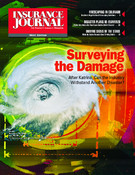The U.S. Court of Appeals, Fifth Circuit, recently issued its opinion in Graphic Packaging International Inc. v. Employers Insurance of Wausau, upholding the validity of an exclusion for “bodily injury by disease” found in workers’ compensation/employers liability policies issued by Wausau.
In its opinion, the appellate court upheld a lower court decision in Louisiana that an asbestos-related disease does not constitute a “bodily injury by accident,” but rather is an “occupational disease.”
“The court’s ruling makes it clear that employers cannot ‘shoe-horn’ coverage of an occupational disease into policy coverage for injuries,” said Bruce Wood, assistant general counsel for the American Insurance Association, which filed a friend-of-the-court brief in the case. “If the court had ruled otherwise, employers with asbestos liabilities owed to their employees would have been able to improperly transfer their decades-old liabilities to insurance policies that did not provide coverage and for which no premium had ever been charged or collected. Insurers would have been hit with retroactive and unfunded liabilities reaching back decades.”
The case originally developed in 2000 when Graphic Packaging (formerly Riverwood International) made a $1.513 million settlement with 260 former and current employees who claimed they were injured by exposure to asbestos at the company’s paperboard manufacturing plant in West Monroe, La. The employer filed a workers’ compensation claim citing “bodily injury by disease.”
The claim was denied by Wausau based on an exclusion in the policies that all claims for “bodily injury by disease” be reported within 36 months after the expiration of the policy period. Graphic Packaging agreed that none of the claims were asserted within 36 months of the policies’ expiration. However, the company argued that the claims merited coverage because they were “bodily injury by accident.”
Graphic Packaging filed suit against Wausau based on what it said was an unclear definition of “accident.” The company argued that language in the policies was ambiguous. Yet the trial court agreed with Wausau and granted summary judgment in its favor.
On appeal before the fifth circuit, AIA, Property Casualty Insurers Association of America and National Council on Compensation Insurance Inc. filed a joint amicus brief arguing there is a statutory difference between “accidents” and “occupational diseases,” and that the distinction should control the corresponding definitions contained in Wausau’s policies. The policy language was supported by Louisiana case law, the trade groups said.
“Employers with asbestos liabilities were attempting to use part of their workers’ compensation policy to off-load their liabilities onto insurers by contorting the English language,” Wood said. The appellate court ruled that there was only one reasonable interpretation: that asbestos-related disease could not be construed as “bodily injury by accident” under the policies, and that asbestos-related disease was a “bodily injury by disease.”
“In essence, the trial court and the appellate both reached the same conclusion … that asbestos-related diseases not reported within the required 36-month period were excluded from coverage,” said Robert Hurns, counsel for the legal division of PCI. “The bottom line is now insurers who provide those kind of policies can rely on contract language. Accident and the disease definitions couldn’t have been clearer. The exclusions were very clear and coincided with the statute.”
According to Tiffany O’Shea, AIA director of public affairs, the decision was significant because it could have a positive effect on similar pending disputes. “There is a pending case right now, USX v. Liberty Mutual in the 3rd Circuit Court of Appeals in Pennsylvania, in which we are trying to reverse an unfavorable court decision against Liberty,” she said. “The briefings were done well over a year ago on USX. So given the favorable decision on Riverwood v. Wausau, we think that in USX, the court will hopefully hear that one sooner rather than later.”
PCI’s Hurns agrees the opinion “should serve as solid guidance for other circuits currently examining the identical issue.” Additionally, he believes the ruling on Graphic Packaging has further implications.
“Any type of coverage you can imagine has been disputed at one time or another. The courts are not supposed to interpret contract language if the language is clear. The only time a court is supposed to interpret contract language is if the language is ambiguous,” he said. “We contend the language [in Employers Insurance of Wausau’s policies] was not ambiguous. It clearly excluded that type of illness and was not caused by the statutory definition of ‘accident.’ We think it was a good decision.”
The trade groups that filed the brief concur that this was a “pretty big deal case,” said AIA’s O’Shea, because it indicates insurers can rely on the language in their policies.
Topics Legislation Workers' Compensation
Was this article valuable?
Here are more articles you may enjoy.


 Michigan Supreme Court Rules Against Couple in Drone Surveillance Case
Michigan Supreme Court Rules Against Couple in Drone Surveillance Case  Miami Retirement Fund Class Action Alleges Globe Life Officers Concealed Fraud
Miami Retirement Fund Class Action Alleges Globe Life Officers Concealed Fraud  Berkshire’s ‘Most Important’ Biz Drives Q1 Results; GEICO Still Behind on Tech
Berkshire’s ‘Most Important’ Biz Drives Q1 Results; GEICO Still Behind on Tech  Insurer Chubb Readies $350M Payout Tied to Baltimore Bridge Collapse
Insurer Chubb Readies $350M Payout Tied to Baltimore Bridge Collapse 


